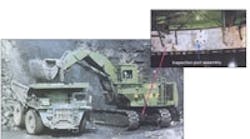The idea is called the Sague Renewable Bearing concept after its inventor, J.E. Sague. A bearing based on it looks much like any typical two-row, large-diameter bearing with cylindrical rolling elements. External bearing dimensions can be the same for both. In the renewable bearing, Figure 1, two removable ports are located in the bearing ring that has no internal gear. One port opens into the bearing’s upper roller channel; the other, on the opposite side of the ring from the first port, opens into the lower roller channel.
Through these ports you can inspect the bearing raceway opposite the plug. You can also inspect or replace the rollers and the spacers between rollers.
What’s in there?
All raceway surfaces in each roller channel are identically machined, ground, and hardened. Depending on roller orientation in the roller channel, any of the raceway surfaces can be used to support the load-carrying rolling elements. When the inner and outer rings are assembled, the raceway surfaces form two square-shaped roller paths. Each of the four raceway surfaces in each roller channel can support loaded rolling elements.
In the assembled bearing, all rollers in the upper roller channel are oriented in the same direction relative to each other and at right angles to the rollers in the lower roller channel. Rollers are proportioned so that roller diameter is slightly larger than roller length and port diameter is large enough so rollers and spacers fit through the holes in the rings in which the ports are installed.
You can periodically remove the ports by means of jacking screws provided, and inspect the rollers, spacers, and raceways opposite the ports. If you find raceway distress severe enough to jeopardize further operation, you can choose to restore the bearing to near original capacity and performance. Just remove the rollers or damaged spacers through the port and reinstall them in reverse orientation as in Figure 1. In that arrangement, the rollers contact previously unused raceway surfaces. You must reorient the rollers and spacers in the other row, too, to maintain the right-angle relationship between rollers in the two rows. You need no special tool to open a port or remove rollers or spacers.
The net effect of reorienting the rollers is to put them in contact with virgin raceways — it is almost like operating with a new bearing.
If inspection shows that the rollers are distressed but the raceways are adequate, you can install new rollers oriented as they were originally to contact the original raceways. Thus, you preserve the unused, back-up raceways. Of course, if the original raceways and rollers are distressed, you must replace the rollers and reorient them to contact the virgin raceways.
You can operate and periodically monitor a bearing thus renewed until you determine that a new bearing should be installed — during normally scheduled maintenance.
But does it work?
According to Mr. Sague, who is principal associate and director of J.E. Sague & Associates, Philadelphia, a consulting firm specializing in rolling-element bearings and rotating structures, “The elimination of lost production due to unscheduled bearing maintenance has been impressive and is well-documented. The concept has been proven in several years’ operation in hydraulic shovel applications in a Canadian surface mine as well as in several stacker/reclaimer applications.” In the shovel application, damaged as well as worn spacers have been replaced in several bearings. Also, a full set of rollers was replaced because the originals were severely worn due to a lubrication error.
Mr. Sague points to another potential cost saver besides avoidance of production loss and emergency-repair premium charges: avoiding the cost of keeping a spare. With value for some large bearings easily hitting six figures, you may be able to avoid the costs of tying up capital in a bearing you hope you’ll never need. Periodic monitoring of bearing condition by viewing through the ports may let you know several months ahead of time when you’ll need a bearing that calls for several months’ procurement lead. You won’t have to stock it as a spare.
The firm is licensing the concept, which is protected under U.S. Patent No. 5,104,239.
For more about the Sague Renewable Bearing concept, contact J.E. Sague & Associates, 702 Princeton St., P.O. Box 24653, Philadelphia, Pa. 19111, phone (215) 342-5084.

